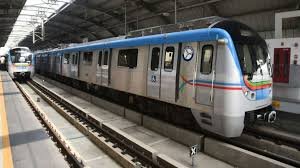
Contents
Hyderabad Metro Rail Phase-1 Project Taken Over by State Government, Paving Way for Faster Execution of Phase-2
The state government of Hyderabad has decided to take over the Hyderabad Metro Rail Phase-1 project from Larsen & Toubro (L&T), marking a significant shift in the city’s urban transport strategy. The decision, finalized at a high-level meeting chaired by Chief Minister A. Revanth Reddy, will enable the government to have complete ownership of Phase-1 and smoother clearance and implementation of the proposed Phase-2A and Phase-2B expansions. The state will absorb nearly Rs 13,000 crore of outstanding debt of L&T Metro Rail Hyderabad Ltd (LTMRHL) and make a one-time settlement of Rs 2,000 crore towards its equity investment.
The state government’s decision to take over the Hyderabad Metro Rail Phase-1 project from Larsen & Toubro (L&T) is a significant development that answers the who, what, where, when, why, and how of the situation. Who is involved? The state government, L&T, and the Chief Minister A. Revanth Reddy are the key players. What is happening? The state government is taking over the Phase-1 project, which includes absorbing nearly Rs 13,000 crore of outstanding debt and making a one-time settlement of Rs 2,000 crore. Where is this happening? The project is located in Hyderabad, which was once ranked second in the country for Metro Rail network length but has now slipped to ninth position. When did this happen? The decision was finalized at a high-level meeting on Thursday, chaired by Chief Minister A. Revanth Reddy. Why is this happening? The takeover is essential for seamless integration of both phases, efficient operations, revenue sharing, and passenger convenience. How will this affect the future of the project? The state government’s ownership of Phase-1 will enable smoother clearance and implementation of the proposed Phase-2A and Phase-2B expansions.
Background and Context
The Hyderabad Metro Rail project was launched in November 2017, after the formation of Telangana, with L&T as the concessionaire. Despite being billed as the world’s largest metro under the public-private partnership (PPP) model, the project ran into financial stress due to mounting losses, cost overruns, alignment changes, and the impact of the Covid-19 pandemic. L&T had signed the Metro PPP concession in July 2009 in undivided Andhra Pradesh and had initially planned to invest in Phase-2. However, the company decided to exit the project, offering to divest its 90% stake in Phase-1 and opting out of Phase-2.
Key Highlights and Benefits
The key highlights and benefits of the state government’s takeover of the Phase-1 project include:
* The state will absorb nearly Rs 13,000 crore of outstanding debt of L&T Metro Rail Hyderabad Ltd (LTMRHL)
* A one-time settlement of Rs 2,000 crore will be made towards L&T’s equity investment
* The government will have complete ownership of Phase-1, enabling smoother clearance and implementation of Phase-2A and Phase-2B expansions
* Seamless integration of both phases will ensure efficient operations, revenue sharing, and passenger convenience
* The takeover will help remove procedural hurdles and secure quicker clearances from the Centre
* Hyderabad’s status as a leading metro hub will be restored
Reactions and Quotes
Chief Minister A. Revanth Reddy emphasized the importance of seamless integration of both phases, stating that it is essential for efficient operations, revenue sharing, and passenger convenience. He also said that the takeover would help remove procedural hurdles, secure quicker clearances from the Centre, and restore Hyderabad’s status as a leading metro hub. L&T was represented by Group CMD S.N. Subrahmanyan, Advisor D.K. Sen, and LTMRHL MD & CEO K.V.B. Reddy, who reiterated the company’s position that it had exited the business of owning and operating transport concessions and could not participate as an equity partner in Phase-2.
Future Plans and Proposals
The state has already submitted proposals for eight new corridors spanning 163 km under Phase-2A and Phase-2B to the Centre. Officials are hopeful that with Phase-1 under government control, approvals for the expansion will be expedited. The proposed expansions will help Hyderabad regain its position as a leading metro hub and provide efficient and convenient transportation to its citizens.
Data and Statistics
Some key data and statistics related to the Hyderabad Metro Rail project include:
* The project has a total length of 72 km, with 64 stations
* The daily ridership is approximately 4.5 lakh passengers
* The project has a total investment of Rs 14,132 crore
* The state government will absorb nearly Rs 13,000 crore of outstanding debt
* A one-time settlement of Rs 2,000 crore will be made towards L&T’s equity investment
Conclusion:
The state government’s takeover of the Hyderabad Metro Rail Phase-1 project is a significant development that will enable smoother clearance and implementation of the proposed Phase-2A and Phase-2B expansions. The takeover is essential for seamless integration of both phases, efficient operations, revenue sharing, and passenger convenience. With the state government’s ownership of Phase-1, Hyderabad is poised to regain its position as a leading metro hub and provide efficient and convenient transportation to its citizens.
Keywords:
Hyderabad Metro Rail, Phase-1 project, Larsen & Toubro, state government, takeover, Phase-2A, Phase-2B, expansions, seamless integration, efficient operations, revenue sharing, passenger convenience, urban transport strategy, public-private partnership, PPP model, Covid-19 pandemic, financial stress, cost overruns, alignment changes, investment, equity investment, debt, settlement, proposals, approvals, Centre, daily ridership, total length, stations, total investment.
Hashtags:
#HyderabadMetroRail #Phase1Project #LarsenAndToubro #StateGovernment #Takeover #Phase2A #Phase2B #Expansions #SeamlessIntegration #EfficientOperations #RevenueSharing #PassengerConvenience #UrbanTransportStrategy #PublicPrivatePartnership #PPPModel #Covid19Pandemic #FinancialStress #CostOverruns #AlignmentChanges #Investment #EquityInvestment #Debt #Settlement #Proposals #Approvals #Centre #DailyRidership #TotalLength #Stations #TotalInvestment
Source link